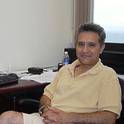
Article
A 52 Hours VLT/FORS2 Spectrum of a Bright z ~ 7 HUDF Galaxy: No Lya Emission
Astronomy & Astrophysics
(2014)
Abstract
Aims: We aim to determine the redshift of GDS_1408, the most solid z _ 7 galaxy candidate lying in the Hubble Ultra Deep Field. Methods: We have used all the VLT spectra of GDS_1408 collected by us and two other groups with FORS2 at VLT in the last five years, for a total integration time of 52hr. The combined spectrum is the deepest ever obtained of a galaxy in the Reionization epoch. Results: We do not detect any emission line or continuum over the whole wavelength range, up to 10100Å. Based on an accurate set of simulations, we are able to put a stringent upper limit of f (Ly_) < 3 _ 1018 erg=s=cm2 at 3-9 sigma in the explored wavelength range, corresponding to a rest-frame equivalent width EW < 9 Å. Combining this limit with the SED modelling we refine the redshift to be z = 6:82_0:1 (1-sigma). The same SED fitting indicates that GDS_1408 is relatively extinct (A1600 ' 1) with a dust corrected star formation rate of ' 20M_yr1. The comparison between the un-attenuated equivalent width predicted by the case-B recombination theory and the observed upper limit, provides a limit on the elective Ly_ escape fraction of f e f f esc (Ly_) < 8%. Even though we cannot rule out a major contribution of the inter/circum galactic medium in damping the line, a plausible interpretation is that G2_1408 is moderately evolved and contains sufficient gas and dust to attenuate the Ly_ emission, before it reaches the intergalactic medium. Conclusions: The redshift confirmation of even the best z ' 7 candidates is very hard to achieve (unless the Ly_ or unusually strong rest-UV nebular emission lines are present) with the current generation of 8-10m class telescopes. We show that both JWST and E-ELT will be necessary to make decisive progresses. Currently, the increased redshift accuracy obtained with this kind of analysis makes ALMA an interesting option for the redshift confirmation.
Keywords
- Galaxies: high - redshift,
- Galaxies: formation,
- Galaxies: distances and redshifts
Disciplines
Publication Date
2014
Publisher Statement
Pre-published version downloaded from ArXiv. Published version is located at http://www.aanda.org/index.php?option=com_article&access=dkey&dkey=10.1051/0004-6361/201424285
Citation Information
E. Venzella, A. Fontana, L. Pentericci, M. Castellano, et al.. "A 52 Hours VLT/FORS2 Spectrum of a Bright z ~ 7 HUDF Galaxy: No Lya Emission" Astronomy & Astrophysics (2014) Available at: http://works.bepress.com/mauro_giavalisco/57/
